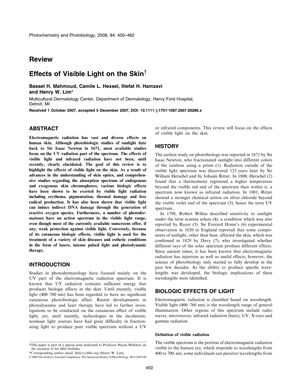Effects of Visible Light on the Skin
January 2008
in “
Photochemistry and Photobiology
”
visible light erythema pigmentation thermal damage free radicals DNA damage photodermatoses sunscreens UVA1 p53-positive cells epidermal proliferation oxidative DNA damage solar urticaria chronic actinic dermatitis phototoxic reactions photoallergic reactions inorganic filters zinc oxide titanium dioxide intense pulsed light photodynamic therapy sunburn skin pigmentation skin damage skin disorders skin cell growth sun allergy chronic sun sensitivity skin reactions allergic skin reactions IPL PDT

TLDR Visible light can damage skin and most sunscreens don't block it well; more research is needed on its effects and protection methods.
The 2008 document reviews the biological effects of visible light (400-700 nm) on human skin, including erythema, pigmentation, thermal damage, and the production of free radicals leading to indirect DNA damage. It notes that visible light can contribute to photodermatoses and that most sunscreens provide weak protection against it. Studies cited include Edstrom et al.'s finding of increased p53-positive cells and epidermal proliferation in 12 individuals exposed to UVA1 and visible light, and Kielbassa et al.'s discovery of oxidative DNA damage extending into the visible light spectrum. The document also discusses the role of visible light in photodermatoses like solar urticaria and chronic actinic dermatitis, as well as phototoxic and photoallergic reactions. It highlights the need for inorganic filters like zinc oxide and titanium dioxide in sunscreens to protect against visible light and discusses the therapeutic uses of light, including intense pulsed light and photodynamic therapy. The document concludes that while the effects of visible light on the skin are partially understood, further research is needed, especially considering its use in medical treatments.





